Looking for adorable pencil art animals? Try sketching playful coffee raccoons, cozy red pandas, gentle ferrets, and affectionate wolves. Draw loving fox duos, cheery rabbits, sleepy sloths, graceful deer, and playful otters holding shells. Don’t stop at these—add a curious blackbird, friendly lizard, nurturing lioness, dreamy wolf by a magic lamp, baby tiger with a butterfly, and more. Each drawing uses soft shading, fluffy textures, and expressive faces. Want inspiration for the rest of your sketchbook? Let’s jump right in!
Key Takeaways
- Capture playful expressions and lifelike textures in animals such as raccoons, foxes, and ferrets for added personality.
- Focus on animal interactions like affectionate wolves and nurturing lionesses to depict warmth, bonds, and family dynamics.
- Use soft pencil shading and gentle line work to portray dreamy scenes featuring mystical wolves, tigers, and magical elements.
- Enhance cuteness by drawing relaxed poses of red pandas, bunnies in meadows, and sleepy sloths among lush natural backgrounds.
- Emphasize character through detailed features: fluffy fur, expressive eyes, and charming behaviors like otters with shells or birds with shiny objects.
Playful Coffee Raccoon Sketch
Pencil in hand, anyone can plunge into the world of playful coffee raccoon sketches, where mischief and cuteness collide in the best way possible.
Picture a raccoon, eyes wide with curiosity, sneaking behind a giant coffee cup, up to its usual raccoon antics. The trick to nailing this vibe? Artists start with soft, rounded lines to show the raccoon’s fluffy fur and that super playful attitude.
Browns and grays, shaded just right, make the fur look extra real, while a few lighter pencil strokes bring the raccoon’s face and that tempting coffee cup to life. White space works like magic here, making the drawing pop and feel joyful.
Adding swirly steam or spilled coffee just ramps up the charm, making everyone smile.
Restful Red Panda Drawing
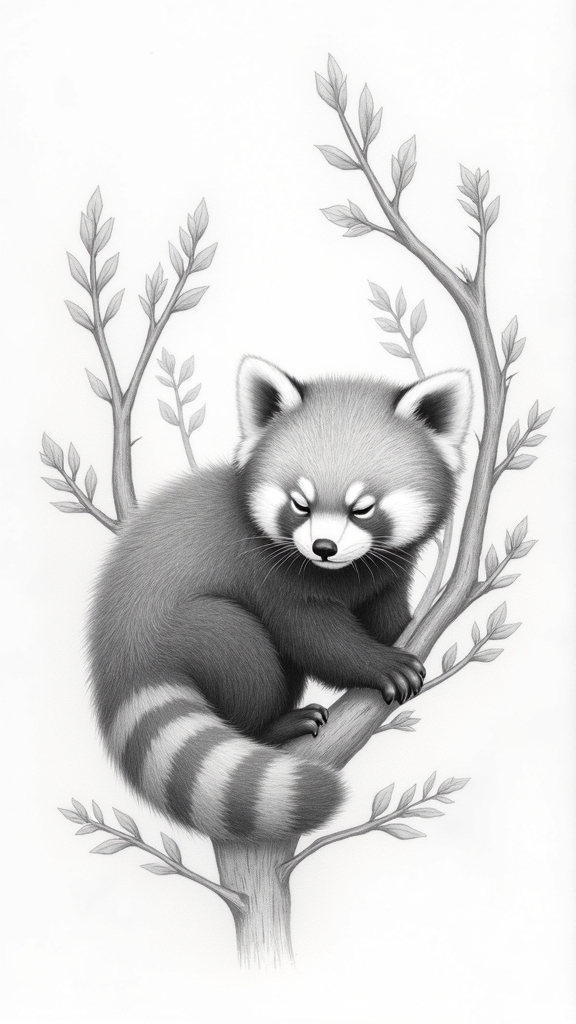
A restful red panda drawing just shouts “chill” with its cozy pose and fluffy, cloud-like fur.
Capturing the panda’s relaxation means choosing a laid-back spot—maybe it’s sprawled out on a branch, eyes half-closed, looking like it just doesn’t care about Monday.
Soft shading is the real hero here, as gentle pencil strokes and careful highlights bring out the red panda’s warm colors and make the whole piece feel as peaceful as a nap on a sunny afternoon.
Capturing Panda Relaxation
How does one capture pure cuteness and total chill in a single drawing? The answer just might be a red panda, the expert in nap time and “I woke up like this” charm.
Artists looking to draw this adorable animal should pay close attention to restful poses—imagine a fluffy red panda draped over a tree branch, dangling like a fuzzy noodle, or curled up with that famously puffy tail hiding its nose.
Don’t forget to sprinkle in hints of its playful antics, too, maybe with a paw hanging off or a lazy blink. By focusing on the red panda’s round face and signature markings, and letting inspiration flow from reference photos, anyone can totally nail that vibe: cute, peaceful, and a tiny bit mischievous.
Soft Shading Techniques
Nothing says “soft and sleepy” quite like a red panda chilling on a tree branch, and that’s exactly the vibe soft shading techniques can capture.
To make your red panda drawing look extra fluffy, artists use soft shading by applying gentle pencil pressure and smoothly blending colors. Start with a light base layer, then add more color in soft, steady layers—no need to press hard!
For extra softness, try circular or oval strokes that follow the panda’s fur, using pencil blending tools or even your finger to blur harsh lines. Remember, leaving a few white spaces between strokes creates shiny highlights, like sunlight hitting silky fur.
Practice shading on the face and paws—before you know it, your red panda will look cuddle-worthy!
Gentle Ferret Portrait
When it’s time to sketch a gentle ferret portrait, every tiny twitch of the nose and bright glint in the eyes counts, because ferrets are full of personality!
Artists can really make these playful creatures pop by capturing their curious expressions and giving their soft fur a lifelike feel with gentle pencil shading.
A few clever pencil strokes and some carefully placed highlights can turn that cute ferret face from flat to almost leaping off the paper—just don’t be surprised if someone tries to rub its fuzzy head!
Capturing Ferret Expressions
Even though ferrets might seem like tiny, mischievous noodles with fur, there’s a certain magic in their expressions that can totally steal the show in a pencil portrait. Their big, sparkling eyes are full of ferret emotions, whether it’s wild curiosity or a dash of playful mischievousness.
Artists should really zoom in on those eyes, plus their little twitchy noses and round cheeks, to get all that feeling onto paper. Playful poses, like a ferret stretching out or popping its head around a corner, bring even more life to the drawing.
Reference photos are super useful for studying those adorable face shapes and expressions. Notice how the shadows and contours work together, helping you create a dynamic, lifelike ferret that almost looks ready to scamper away.
Soft Pencil Techniques
To really capture the gentle spirit of a ferret in pencil, artists can immerse themselves in soft techniques that make the drawing almost glow.
Forget hard lines—this is all about gentle shading and smooth shifts! Start with a light sketch of the ferret’s face and long, wiggly body, really focusing on its playful, curious eyes.
Soft pencil techniques mean you should shade with a light touch, using blending tools or even your finger for that fluffy, cloud-like fur effect.
Leave some areas white—especially on the cheeks and belly—so the ferret looks bright and soft.
Layer your pencil strokes slowly like you’re building up an invisible fluff pile. Taking your time with gentle shading makes the portrait lifelike and irresistible—almost like petting real fur!
Affectionate Wolves in Pencil
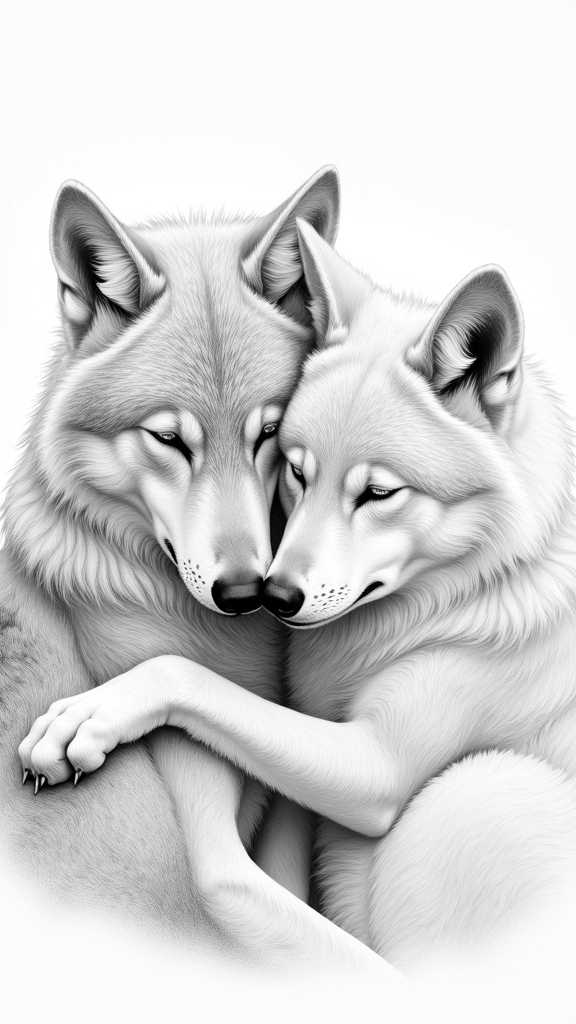
Wolf art, especially in pencil, can really tug at your heartstrings. There’s something magical about capturing wolf pack dynamics—like a mother wolf cuddling her playful pups or two siblings nuzzling in the snow.
Artists love to focus on these nurturing behaviors, using soft shading and gentle lines to highlight the warmth and love within the pack. These bits of pencil magic make you feel like you’re peeking into a secret world where family means everything, even if they howl instead of chat.
The cloud-like softness of pencil sketches gives wolves an extra tender look, turning fierce animals into fuzzy family members. When artists draw affectionate wolves, they help everyone see how important love and family are—even in the wildest places.
Loving Foxes Duo Art
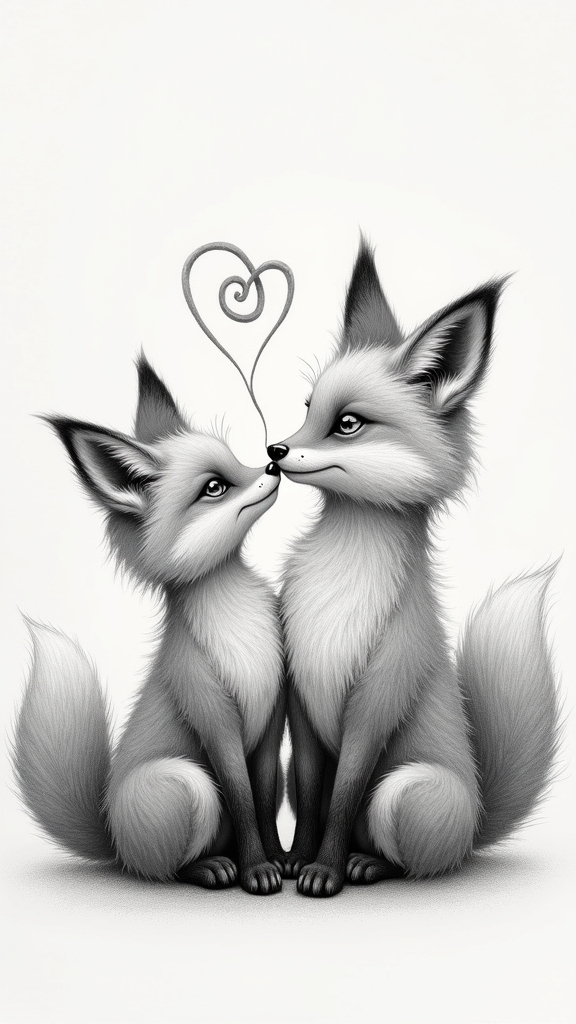
There’s just something completely adorable about two foxes caught in a tender moment. In the “Loving Foxes Duo Art,” the foxes’ playful poses and cozy closeness make it hard not to smile.
Their soft, gentle fox expressions are a lesson in showing emotion through art—one fox has its eyes nearly closed as if giggling at an inside joke, while the other looks on with pure affection.
Soft, gentle fox faces capture sweetness—one giggles with closed eyes, while the other gazes back with heartfelt affection.
The drawing techniques really shine here. Soft shading, fluffy white spaces, and clever line work give their fur a cloud-like feel, practically begging you to reach out and pet them (good luck!).
Artists can learn a lot by studying this piece, especially when it comes to showing relationships and practicing those tricky fur textures.
Curious Baby Tiger and Butterfly
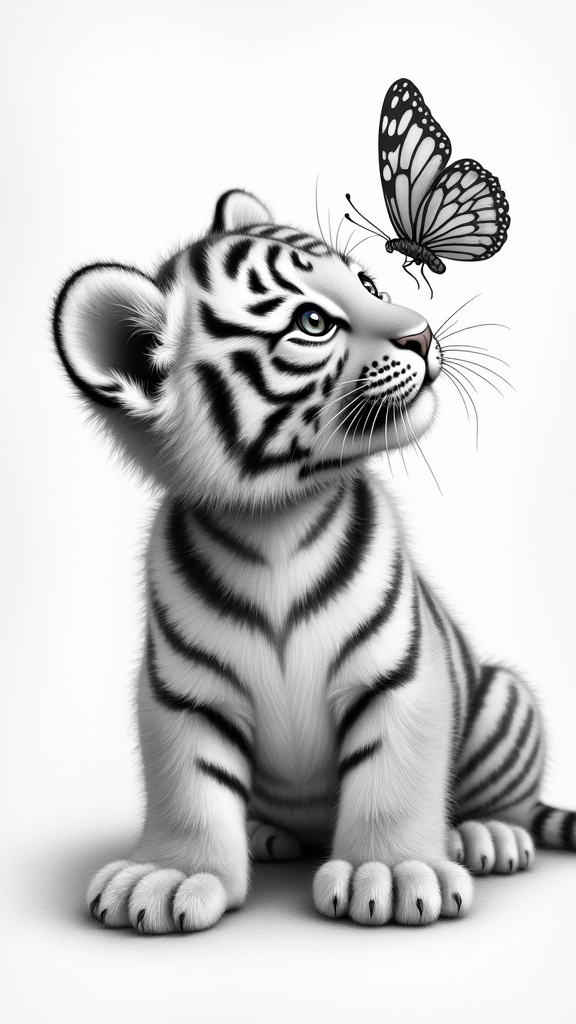
With the “Curious Baby Tiger and Butterfly” drawing, animal friendships get a seriously adorable upgrade—there’s strength and softness all in one frame!
The way the artist uses gentle pencil strokes and clever shadings lets the baby tiger’s huge, curious eyes sparkle, while a tiny butterfly flutters nearby, totally stealing the show.
It’s a perfect scene for practicing how pencil tricks can turn a simple moment into something magical and packed with personality.
Gentle Animal Interactions
Imagine a baby tiger tiptoeing through the grass, its big, curious eyes completely locked onto a tiny butterfly that’s fluttering nearby like it owns the place. This simple scene shows how a tiger butterfly meeting can feel magical, almost like an unexpected friendship in the wild. The huge, stripy paws of the baby tiger look comically massive next to the delicate butterfly wings—talk about opposites! With every light movement, the butterfly brings out the softer side of the tiger, proving that even nature interactions can be gentle and sweet. Anyone sketching this moment might use soft pencil shading for the tiger and a pop of color for the butterfly—just to make the whole thing feel extra heartwarming.
| Strength | Delicacy | Wonder |
|---|---|---|
| Baby tiger | Butterfly | Gentle pause |
| Power paws | Fragile wings | Friendly gaze |
| Cautious step | Brave flutter | Shared moment |
Expressive Pencil Techniques
Pencil artists looking to bottle up that sweet baby tiger-butterfly moment might want to get a little creative with their techniques.
Capturing the soft, fuzzy look of a tiger cub and the delicate wings of a butterfly calls for expressive layering and some wild dynamic contrasts. An artist can show off the tiger’s curiosity and the butterfly’s gentle poise with clever use of pencil strokes and shading.
Want your drawing to pop? Here’s how to make it happen:
- Use light pencil strokes for the tiger’s fur and leave white spaces for a breezy, lively vibe.
- Play with expressive layering and gradual shading to create depth and softness.
- Grab a range of pencils—softer for shadows, harder for the butterfly’s tricky details.
Snarling Tigers Expression
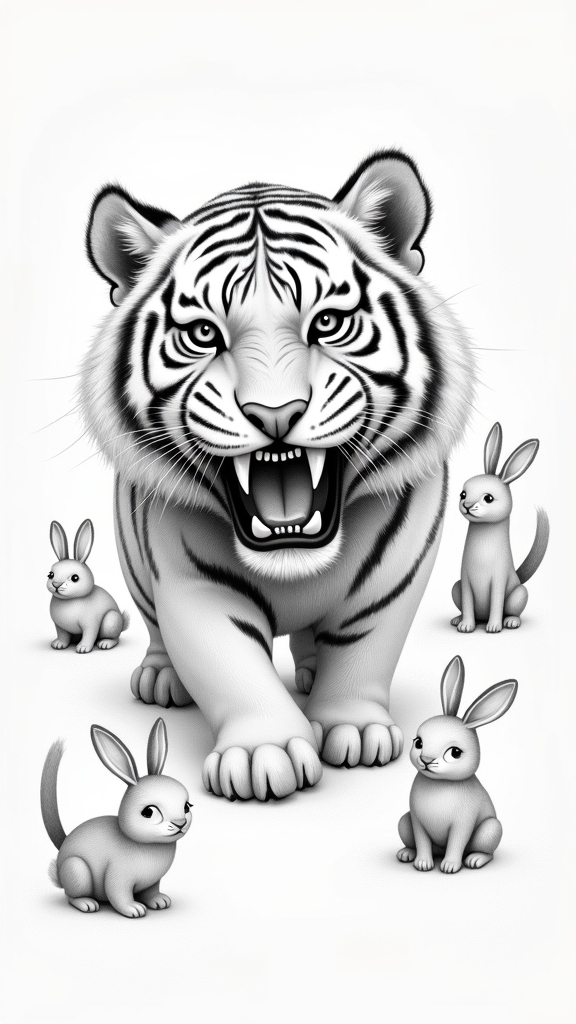
Although tigers are known for their majestic beauty, nothing grabs attention quite like the wild, fierce expression of a snarling tiger. The secret to capturing that intense, almost scary look starts with understanding snarling tiger anatomy.
Check out how their eyes narrow, lips curl, and sharp teeth flash—yikes, talk about a bad hair day! Fierce expression techniques like layering pencil shades, using soft pencils for fluffy fur, and hard pencils for razor-sharp eyes and teeth really bring everything to life.
Observing photos helps artists spot the fine details in a tiger’s muscle lines and wrinkled nose. Switching up angles? That’s where your drawing turns from “meh” to mind-blowing, because tigers always keep us guessing—or running!
Dreamy Wolf and Magic Lamp

When a wolf floats beside a magic lamp, things get delightfully weird in the best way possible. This dreamy wolf, with soft cloud-like fur, seems to slip right out of a storybook and into a world where mystical creatures roam dreamy vistas.
The magic lamp glows under its chin, hinting at wishes, adventure, and maybe a little mayhem. Artists who want something magical in their sketchbooks will love capturing the wolf’s calm eyes and the gentle light from the lamp.
Here’s how anyone can bring this enchanting scene to life:
- Combine gentle pencil strokes to create the dreamy vistas.
- Use contrasting textures to highlight the wolf as a mystical creature.
- Play with shading to make the lamp look like it’s glowing with curiosity.
Wolf Pack in the Wilderness
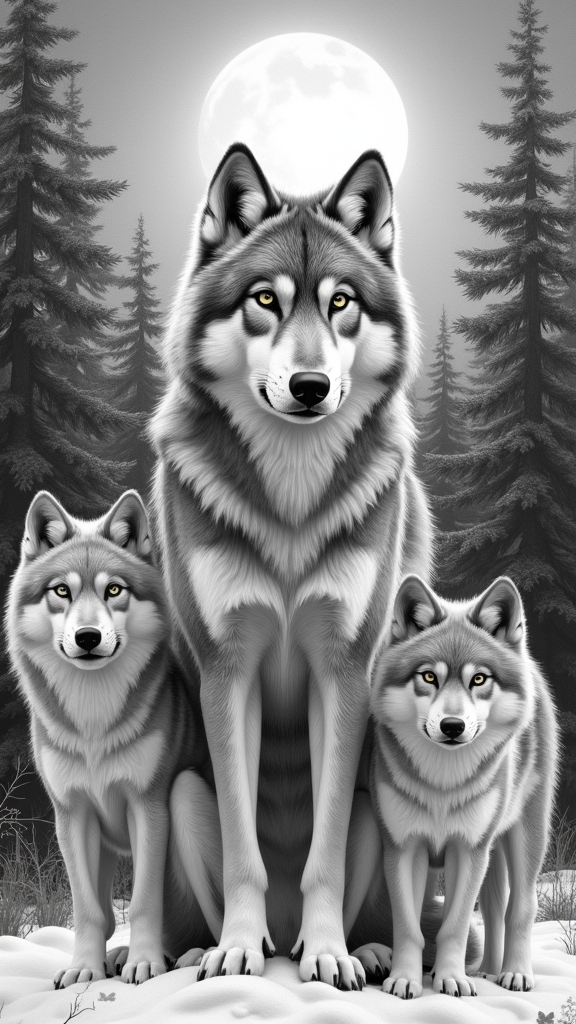
When drawing a wolf pack in the wilderness, artists get the chance to show off just how powerful and close-knit these animals really are.
It’s not just about sketching a bunch of wolves hanging out—each one has its own spot and personality, whether it’s the serious alpha up front or the playful pups tagging along in the back.
Dynamic Group Composition
Nothing screams “teamwork” in the animal kingdom quite like a wolf pack roaming across the wild.
When sketching these majestic creatures, it’s all about capturing their wolf pack dynamics within their wilderness habitat. Think about it: wolves rarely travel alone, so drawing them in a group tells a bigger story of cooperation and adventure.
To make your group composition pop, try these ideas:
- Vary their poses—Have some wolves looking ahead, another howling, maybe one sniffing snow, to show different roles and personalities.
- Mix up their placement—Scatter wolves at different distances, weaving them around trees or rocks for depth and excitement.
- Add environmental details—Include mountains, snow, or forests to ground your wolf pack in a believable wilderness habitat.
Ready? Let your pack run wild!
Expressing Natural Behavior
Ever wonder what really goes on in a wolf pack out in the wild? Out there, it’s not just a bunch of wolves howling at the moon for fun.
Wolf interactions are a roller coaster—one minute they’re all business during a hunt, the next, pups are wrestling, tumbling around like furry athletes-in-training. The secret to their teamwork? Pack communication.
Wolves trade info with tail wags, ear twitches, and a whole chorus of howls, yips, and growls. It’s like they have their own secret wolf language, which is actually pretty cool!
Even little things—like sharing food or giving each other a good grooming—help form powerful family bonds. Artists love capturing these moments, because drawing real wolf behavior means showing the wild, loving heart of a pack.
Blackbird With Shiny Ring
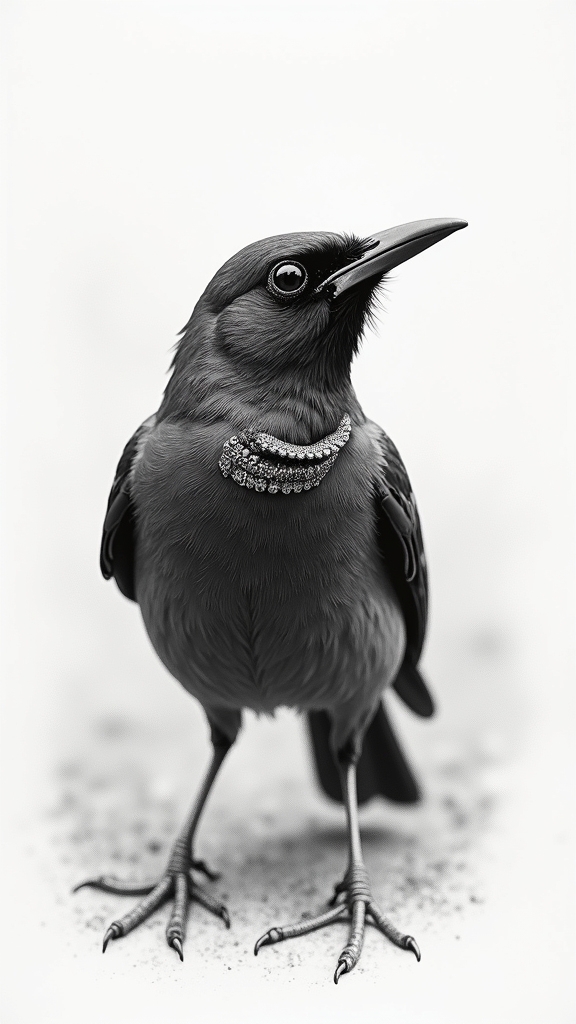
A curious blackbird sits on a branch, beady eyes fixed on a shiny ring that glimmers just out of reach. This scene mixes blackbird symbolism—often tied to curiosity, mystery, or cleverness—with the ring’s significance as a symbol of secrets, treasures, or maybe even trouble.
The artist uses soft lines and gentle shading to give the blackbird’s feathers a lifelike, shimmery look, making the bird feel almost alive on the page. The shiny ring pops, pulling everyone’s gaze, and adds a playful hint of fantasy to an otherwise realistic moment.
Soft lines and gentle shading bring the blackbird to life, while the sparkling ring adds a touch of whimsical magic.
If you want to try drawing this scene, remember:
- Use different pencil pressures for rich feather textures.
- Add highlights for the ring’s gleam.
- Imagine your own story for the curious duo!
Cozy Lizard on a Sofa

Slippers, sunshine, and a sofa—turns out, lizards enjoy the comfy life just as much as anyone else. Imagine a lizard, sprawled on a couch, looking completely at home.
This pencil art scene brings out so much lizard personality; maybe it’s curious, maybe it just wants to nap. The real magic comes from those contrasting sofa textures—soft fabric folds meet rough, scaly skin.
Artists love playing with light and shadow here, making the lizard look both cozy and three-dimensional. If you want to turn up the charm, add a tiny cushion, or a book left open like the lizard’s halfway through a mystery.
The warmth and tranquility of this drawing make you almost wish you had a pet lizard living room buddy.
Tender Lioness and Cub
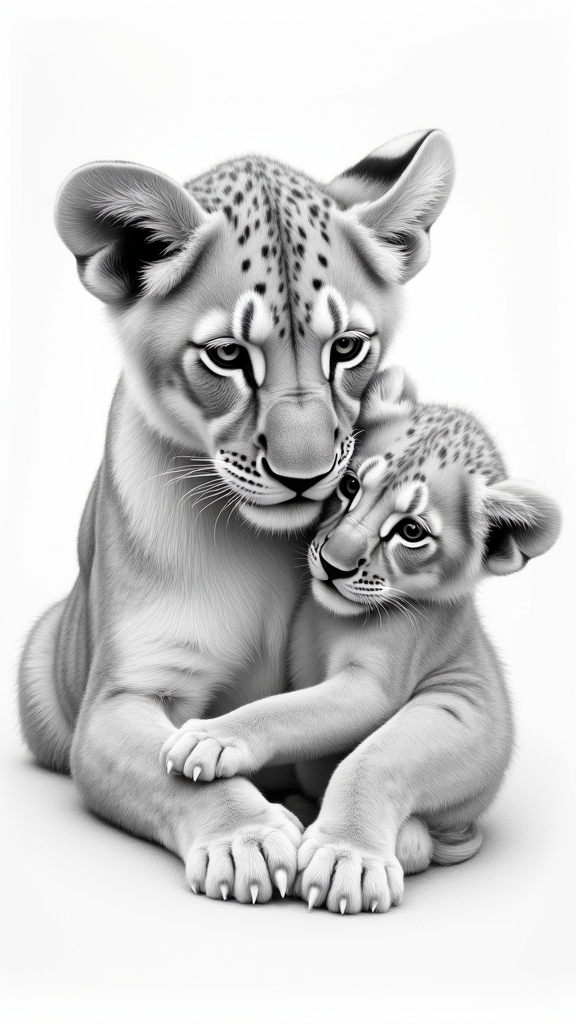
Motherhood in the wild has its own kind of magic, and nothing says “aww” quite like a lioness snuggled up with her rambunctious cub.
Drawing this duo? It’s a heartwarming challenge! Artists pay special attention to lioness anatomy—the big, powerful muscles softened by fur, and that watchful face smiling down at her little troublemaker.
Capturing their nurturing behavior means showing the gentle way she curls her paw or the cub’s playful leap into her side. For extra warmth, light pencil strokes and blending bring out the soft fur and sunny savanna background.
If you want your picture to pop with emotion, try this:
- Observe reference photos to nail the details.
- Focus on facial expressions for personality.
- Use shading for warmth and realism.
Cheery Rabbit in the Meadow

Anyone who’s met a wild rabbit knows those tiny noses and twitchy ears are about as adorable as it gets. In pencil art, the cheery rabbit in the meadow truly comes alive with fluffy fur and long, playful ears, showing off all sorts of rabbit expressions. Artists use gentle pencil strokes to make the fur look super soft, basically begging for a gentle poke. Adding a burst of wildflowers and layering in many meadow colors, from bright greens to pops of yellow, creates a scene packed with energy and joy. Don’t forget the blue sky—it turns the whole drawing into a sunny haven. Leaving some white spaces brings shine, as if the rabbit just hopped out from a dream.
| Rabbit Trait | Meadow Feature | Artistic Trick |
|---|---|---|
| Fluffy body | Wildflowers | Light pencil strokes |
| Long, upright ears | Green grass | Color layering |
| Playful expression | Blue sky | Highlight spaces |
Sleepy Sloth Hanging From a Branch

Over in the treetops, far above the busy meadow where rabbits bounce and wildflowers dance, a sleepy sloth hangs out like the ultimate nature couch potato.
With superhero-long limbs, curved claws gripping a sturdy branch, and that signature chill expression, the sloth is living its best slow-motion life.
When sketching this fuzzy tree-dweller, paying attention to sloth anatomy is key—those dangly legs and gentle face say it all.
The tree habitat should feel alive too: leafy, lush, and just right for a snooze.
Soft pencil strokes make fur look fluffy and relaxed, like a cloud with a spine.
For a sloth that really slays, try:
- Layer fur with gentle, wavy lines
- Emphasize curved claws on the branch
- Add leaf details for habitat charm
Graceful Deer Among Flowers
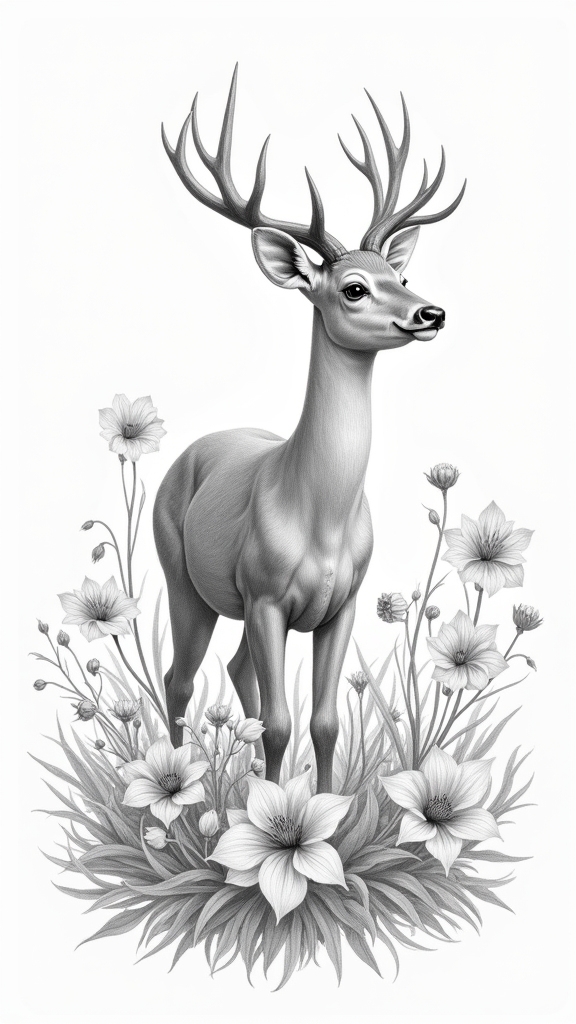
Magic happens when a graceful deer steps into a meadow bursting with flowers—suddenly the whole drawing feels alive and peaceful, almost like a scene from a fairy tale.
To capture this moment, artists pay close attention to deer anatomy, focusing on the gentle arch of the deer’s neck, their slender legs, and those huge, curious eyes. These little details help bring out the animal’s natural elegance.
Meanwhile, floral arrangements scattered around the deer—maybe daisies, wildflowers, or swaying grasses—add a splash of color and texture that makes the scene even more enchanting.
Shading tricks like cross-hatching and blending give depth, making the deer pop out from the wildflowers. Drawing from reference images helps nail the look, making every detail believable—and magical.
Playful Otter Holding a Shell
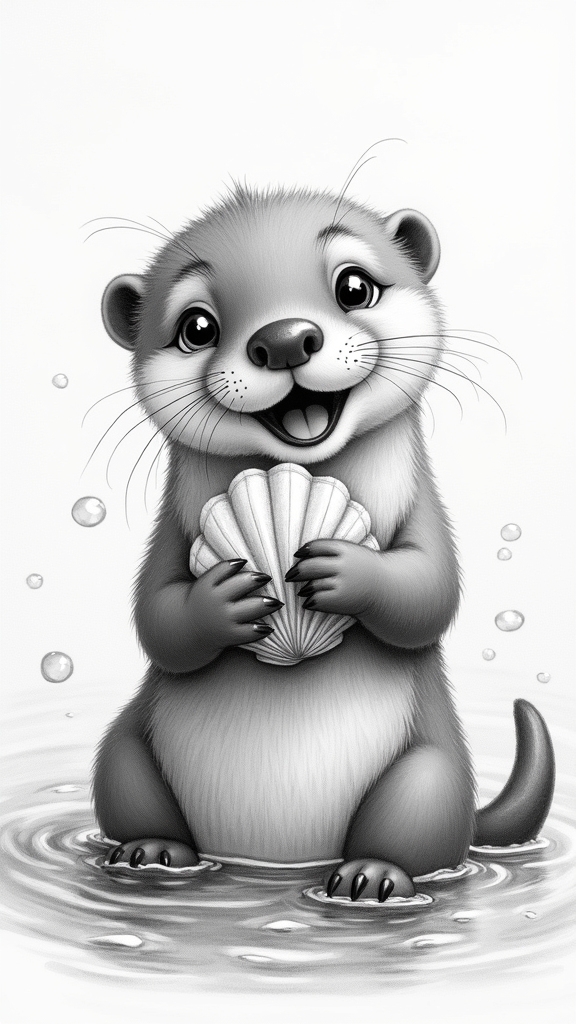
Few animals are as ridiculously adorable as a playful otter lounging on its back, shell in paw and a mischievous sparkle in its eyes. Drawing this scene in pencil brings out so many fun details.
Otter anatomy can be quirky: short legs, webbed feet, and a long, flexible body perfect for playful movements. Their fur looks shiny and soft, which is awesome to show using light and dark pencil shades. Don’t forget their expressive face—after all, that’s where their mischievous charm lives! Adding water ripples or shiny reflections underneath makes your drawing pop even more.
To make your otter art extra fun:
- Use varied strokes for fuzzy fur.
- Capture playful movements in their pose.
- Add watery backgrounds for a splashy effect!
Frequently Asked Questions
What Can an 11 Year Old Draw?
An 11-year-old can draw favorite animals like cats, dogs, or rabbits using basic shapes for structure. Drawing tips include using colored pencils for vibrancy and studying reference images to practice accuracy and improve overall artistic skills.
Which Animal Is Easiest to Draw?
When considering which animal is easiest to draw, one might note that animals like cats or turtles use simple shapes and beginner techniques. Their basic geometric outlines make them ideal for those just starting to practice drawing skills.
How to Draw Animals Easily With a Pencil?
Drawing animals easily with a pencil involves starting with basic shapes to establish animal proportions, then refining outlines. Light sketches enable corrections. Pencil shading techniques add depth, while observing unique features helps capture realism and character in the drawing.
What Is the Cutest Thing to Draw?
The current question explores what artists consider the cutest subject to draw. Often, cute animal sketches featuring gentle poses and big eyes, combined with adorable drawing techniques, such as light shading and soft lines, create irresistibly charming artwork.
Conclusion
Drawing animals in pencil is like creating your own secret zoo, one sketch at a time. Each creature—from raccoons to playful otters—brings its own spark of personality and a dash of cuteness to the page. Even if your fox ends up looking like he’s had too much coffee, that’s part of the fun! So grab your pencil, let your lines roam free, and remember: every adorable animal sketch is a win, even the silly ones.

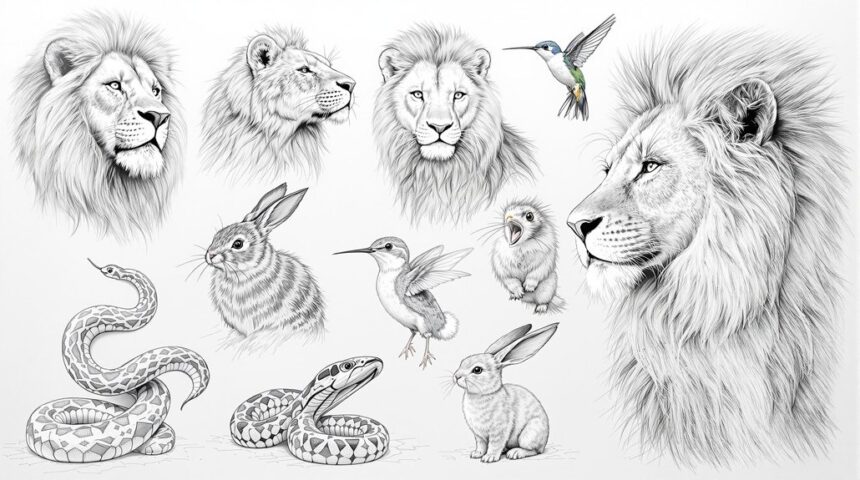
Leave a Reply